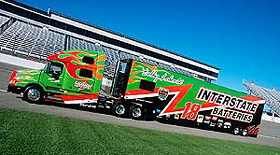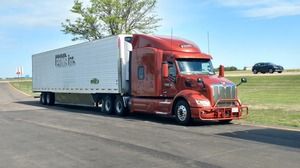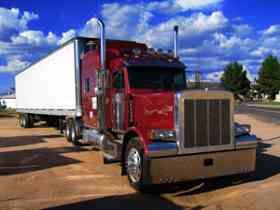Dry Van Or Reefer
Topic 12373 | Page 1
Which would you reccomend I start out with & why? Does either get more miles than the other? Longer wait times? Etc curious to know.
Refrigerated gets more average miles than dry van. From my research and observations, it also tends to have tighter delivery windows, and it is somewhat more work, making sure it is operational and working properly. They also start out at a slightly higher cpm , on average.
Before flatbedding got into my blood, Refrigerated was my choice. It is still my second choice, before dry van.
Dry Van:
A trailer or truck that that requires no special attention, such as refrigeration, that hauls regular palletted, boxed, or floor-loaded freight. The most common type of trailer in trucking.CPM:
Cents Per Mile
Drivers are often paid by the mile and it's given in cents per mile, or cpm.

Which would you reccomend I start out with & why? Does either get more miles than the other? Longer wait times? Etc curious to know.
I like dry van myself. After I drop my load on Monday, I'll have 3000 miles for the week. Which is what you want
Dry Van:
A trailer or truck that that requires no special attention, such as refrigeration, that hauls regular palletted, boxed, or floor-loaded freight. The most common type of trailer in trucking.
So far I have done reefer , flatbed, dry van , and containers.
As far as miles, depends on the company and where you will be doing most of your driving.
I have driven for Prime, Barr Nunn, JB Hunt, and now locally from the ports in Norfolk VA. Did reefer and flatbed for Prime, plenty of miles on both sides of Prime. Barr Nunn was dry van, plenty of miles there as well. Just did not like their way of doing things, talked a good game but did not deliver on promises. Did dry van with JB Hunt on the dedicated Georgia Pacific account, averaged about 2100 miles/week. Left JB because of medical issues last spring. Now drive for a local group pulling containers from the port here in Norfolk VA. Mostly drive in VA/NC/WV with the occasional trip to OH/KY. Did have an opportunity to take a dry van out to OK and back just before the holidays, that was fun.
So, to answer your question, it depends on what you want as to what will work best for you. Least amount of work is with reefer/dry van, but lots of wait time depending on where you pickup/deliver Dry van can be mostly drop/hook depending on the location which equates to little wait time.
Flatbed had lots more work involved (strapping/tarping/chaining) to secure your load. Usually less waiting at shipper/receiver.
I would recommend doing either reefer or dry van to start so you can concentrate on learning how to do your job. Then if you want, change to flatbed if you want a new challenge.
Hauling into/out of ports has their own unique issues. At least here in the Norfolk VA area, dealing with the ports on a daily basis can be a real challenge.
Ernie
Shipper:
The customer who is shipping the freight. This is where the driver will pick up a load and then deliver it to the receiver or consignee.
Dry Van:
A trailer or truck that that requires no special attention, such as refrigeration, that hauls regular palletted, boxed, or floor-loaded freight. The most common type of trailer in trucking.Reefer:
A refrigerated trailer.

Thanks for the replies guys! I was also taking in to consideration I don't know if this is true or not. But I've heard that in the beginning of the year that freight slows down like between January & March. So if you drive dry Van you are getting less miles & more waiting rather than if you drive reefer you still are moving since stores & people always need food. Like I said this is just what I've ready other places. Anyone know this to be true or not?
Dry Van:
A trailer or truck that that requires no special attention, such as refrigeration, that hauls regular palletted, boxed, or floor-loaded freight. The most common type of trailer in trucking.Reefer:
A refrigerated trailer.

I have drive, for swift dry van and right now swift reefer both ort. When I was doing dry van . most of my loads were 400 to 500 mile runs, Drop and hook. Doing reefer lots of runs were 1200 miles + with 1800 to 2000 miles not being uncommon. Doing reefer most everything is live load and live unload. Also lots of time there are multi stops on reefer loads weather drops or pick ups. I have got the best over all miles running reefer. As for the freight drying up I have hurd that as well , never did dry van over the holidays and Jan to March. So can't speak to that. Reefer I see a small drop in freight but not much. Only about 200 miles a week. You can tell swift what you want to do weather it's dry or reefer. Not that it want really matter when they put you on a mentors truck just is about what trucks are were when you are ready to go. You will tell them when you upgrade what you want to do . I have not done flatbed I know that a special week long school on top of the rest of it, and pays I think 1cpm better. Lastly if you are a trained reefer, flatbed or hazmat driver don't expect to be able to move around to much at swift as in go flatbed to reefer or to dryvan. They are so short good drivers in those fields that when your in they like to keep you there and make it rather hard to move. As a reefer driver the only time I run dry vans anymore is when I am being lent out to another fleet or there is now reefer freight and they need to get me back to my account. Good look
HAZMAT:
Hazardous Materials
Explosive, flammable, poisonous or otherwise potentially dangerous cargo. Large amounts of especially hazardous cargo are required to be placarded under HAZMAT regulations
Dry Van:
A trailer or truck that that requires no special attention, such as refrigeration, that hauls regular palletted, boxed, or floor-loaded freight. The most common type of trailer in trucking.Dryvan:
A trailer or truck that that requires no special attention, such as refrigeration, that hauls regular palletted, boxed, or floor-loaded freight. The most common type of trailer in trucking.CPM:
Cents Per Mile
Drivers are often paid by the mile and it's given in cents per mile, or cpm.
Reefer:
A refrigerated trailer.
Drop And Hook:
Drop and hook means the driver will drop one trailer and hook to another one.
In order to speed up the pickup and delivery process a driver may be instructed to drop their empty trailer and hook to one that is already loaded, or drop their loaded trailer and hook to one that is already empty. That way the driver will not have to wait for a trailer to be loaded or unloaded.
HOS:
Hours Of Service
HOS refers to the logbook hours of service regulations.
I have drive, for swift dry van and right now swift reefer both ort. When I was doing dry van . most of my loads were 400 to 500 mile runs, Drop and hook. Doing reefer lots of runs were 1200 miles + with 1800 to 2000 miles not being uncommon. Doing reefer most everything is live load and live unload. Also lots of time there are multi stops on reefer loads weather drops or pick ups. I have got the best over all miles running reefer. As for the freight drying up I have hurd that as well , never did dry van over the holidays and Jan to March. So can't speak to that. Reefer I see a small drop in freight but not much. Only about 200 miles a week. You can tell swift what you want to do weather it's dry or reefer. Not that it want really matter when they put you on a mentors truck just is about what trucks are were when you are ready to go. You will tell them when you upgrade what you want to do . I have not done flatbed I know that a special week long school on top of the rest of it, and pays I think 1cpm better. Lastly if you are a trained reefer, flatbed or hazmat driver don't expect to be able to move around to much at swift as in go flatbed to reefer or to dryvan. They are so short good drivers in those fields that when your in they like to keep you there and make it rather hard to move. As a reefer driver the only time I run dry vans anymore is when I am being lent out to another fleet or there is now reefer freight and they need to get me back to my account. Good look
Thanks for the info!
HAZMAT:
Hazardous Materials
Explosive, flammable, poisonous or otherwise potentially dangerous cargo. Large amounts of especially hazardous cargo are required to be placarded under HAZMAT regulations
Dry Van:
A trailer or truck that that requires no special attention, such as refrigeration, that hauls regular palletted, boxed, or floor-loaded freight. The most common type of trailer in trucking.Dryvan:
A trailer or truck that that requires no special attention, such as refrigeration, that hauls regular palletted, boxed, or floor-loaded freight. The most common type of trailer in trucking.CPM:
Cents Per Mile
Drivers are often paid by the mile and it's given in cents per mile, or cpm.
Reefer:
A refrigerated trailer.
Drop And Hook:
Drop and hook means the driver will drop one trailer and hook to another one.
In order to speed up the pickup and delivery process a driver may be instructed to drop their empty trailer and hook to one that is already loaded, or drop their loaded trailer and hook to one that is already empty. That way the driver will not have to wait for a trailer to be loaded or unloaded.
HOS:
Hours Of Service
HOS refers to the logbook hours of service regulations.New Reply:
New! Check out our help videos for a better understanding of our forum features

















Preview:








 TT On Facebook
TT On Facebook
Which would you reccomend I start out with & why? Does either get more miles than the other? Longer wait times? Etc curious to know.